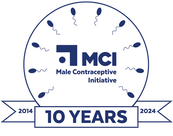|
In this featured blog post, MCI’s Executive Director, Heather Vahdat, shares her thoughts on the need for male contraception and how the field can work to accelerate the introduction of new male methods. My experience working in women’s contraceptive research and development over the past decade has periodically included passing conversations about male methods. The conversations were often brief due to a lack of appetite for funding such work and perceptions that men will not use contraception. Many also assume that even if men are willing to use contraception, their partners will not trust them to do so effectively. Despite having little to no financial support, a few tireless advocates tended to the spark of promise that male methods offered. Their efforts kept the discussion around male contraception alive continued to drive the field forward slowly but surely.
In 2017, while I was part of a team conducting human-centered design research to identify new approaches to female contraception, the question of “What about men?” was raised on a regular basis. Even more interesting was the fact that this question was coming from women and men across a diverse spectrum of ages and relationship statuses in both urban and rural settings in Kenya and India, societies in which the onus of contracepting has historically been placed on the woman. A Rapid Introduction: Beyond Condoms and VasectomyHaving recently transitioned into the male contraception space, I have been fortunate to gain a rapid introduction to the field through a series of serendipitously timed events. Beyond learning about the activities supported directly by MCI, I had the pleasure of attending an annual meeting of scientists working on very early stage male contraceptive targets. Soon after, MCI issued our first request for proposals specifically targeting later-stage products, primarily devices focused on reversible vas occlusion (like vasectomy, only less invasive and reversible). These early exposures, coupled with a responsive and supportive community, have allowed me to quickly gather an idea of the time that it will take new male contraceptives to reach the market. As I worked on developing a strategy for near-term MCI activities, I considered all that I learned in my first few weeks as MCI’s Executive Director. I created a rough product development timeline that included all of the male methods that I learned about and tried to identify opportunities where MCI could provide the most impactful support. During this process, a clear theme started to emerge, one that articulates the fundamental challenge to developing any new product while also, somewhat conversely, reflecting a general sentiment that I often hear when telling people that MCI’s goal is the development of new male contraceptives: “It’s about time“. Accelerating the Process Plotting non-hormonal male contraceptive methods in development across the product development timeline immediately reveals an unbalanced pipeline. The majority of potential products are in the early discovery phase with just a handful of products, exclusively vas occlusive devices, approaching IND-enabling pre-clinical studies. The development timeline is rounded out by a scarcity of products that report being in various stages of clinical trials. However, these trials are being conducted in countries that are not managed by Stringent Regulatory Authorities (SRAs). This means that the ability to use data from these trials to support international registration efforts could be challenging. With these challenges in mind, the first step of increasing the number of male contraceptives available is to focus on moving earlier stage products forward more rapidly: “It’s about speeding up time”. Ensuring a Clear Path In addition to pushing early leads forward, I also considered how we might push from the other end of the pipeline. How can we prepare for downstream activities to ensure that accelerated product development efforts don’t hit a wall at the pre-clinical or clinical stages? Given that there is little to no precedent for navigating male contraceptive methods through the regulatory process, we need to start having discussions across a broad stakeholder set now to ensure that the steps to achieve regulatory approval are clear. This will ensure that time and efficiency is managed at BOTH ends of the development spectrum resulting in an acceleration of the process: “It’s about effectively compressing time”. Communicating a Reality We can develop male contraceptive methods until the cows come home but unless the cows will be using the methods, we also need to work in parallel to study and define the market and potential users. This is tricky when trying to define a market that does not yet exist. In fact, there isn’t even a strongly comparable market for male contraception (i.e., the market for male contraception is likely not analogous to that for female contraception). Male methods, particularly non-hormonal methods, are likely to have mechanisms of action that are quite different than female methods. Most notably, non-hormonal male methods are likely to have fewer, or ideally none, of the side-effects that are commonly experienced with female contraception. The very concept of male contraceptive methods beyond condoms and vasectomy is still so foreign that it is intangible for many men. Thus, a critical aspect of conducting market research is not only defining the potential market and user characteristics for male methods, but also simply getting men and women to consider a world where multiple male contraceptive methods exist. This normalization process is particularly critical given the fact that the anticipated users of many of the male contraceptives in development are currently infants! By normalizing the conversation with today’s adolescents and adults, the concept of male contraception will be less foreign by the time that products currently in development and the first users mature to a point of intersection: “It’s about time to talk about increased contraceptive options for men as a reality”. It’s ALL About Time We stand at a point where virtually all aspects of the discussion around increasing the number of male contraceptives available to men and their partners relates to some form of time acknowledgement. While the concept of time varies depending on which aspect is being discussed, the answer to many of the “how” and “why” questions related to increasing male contraceptive methods is consistent. However, nowhere is the answer more powerful than in response to the fundamental question: “Why should we be investing in developing more male contraceptive methods?” Because, It’s about time.
0 Comments
Your comment will be posted after it is approved.
Leave a Reply. |
Categories
All
Archives
June 2024
|
|
|
Donate to Male Contraceptive InitiativeYour generous donation makes a difference!
|
© Male Contraceptive Initiative. All rights reserved.


 RSS Feed
RSS Feed
